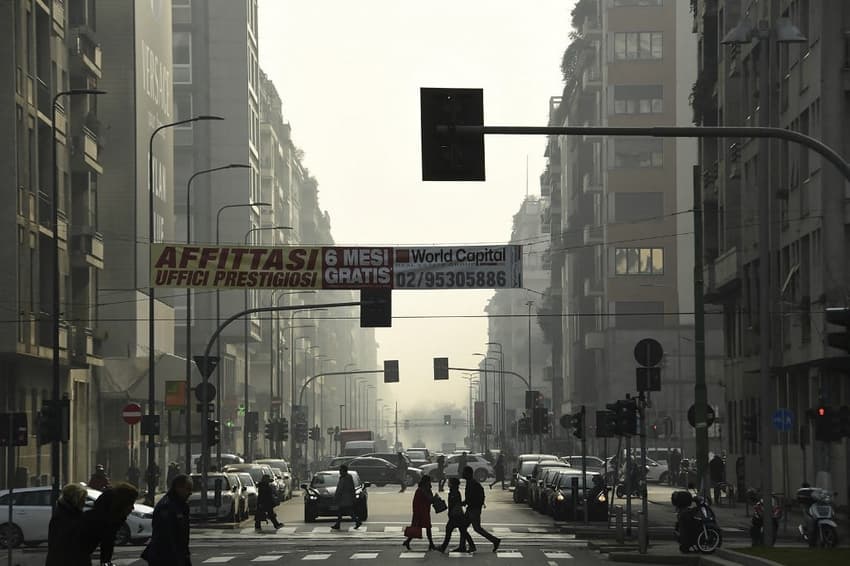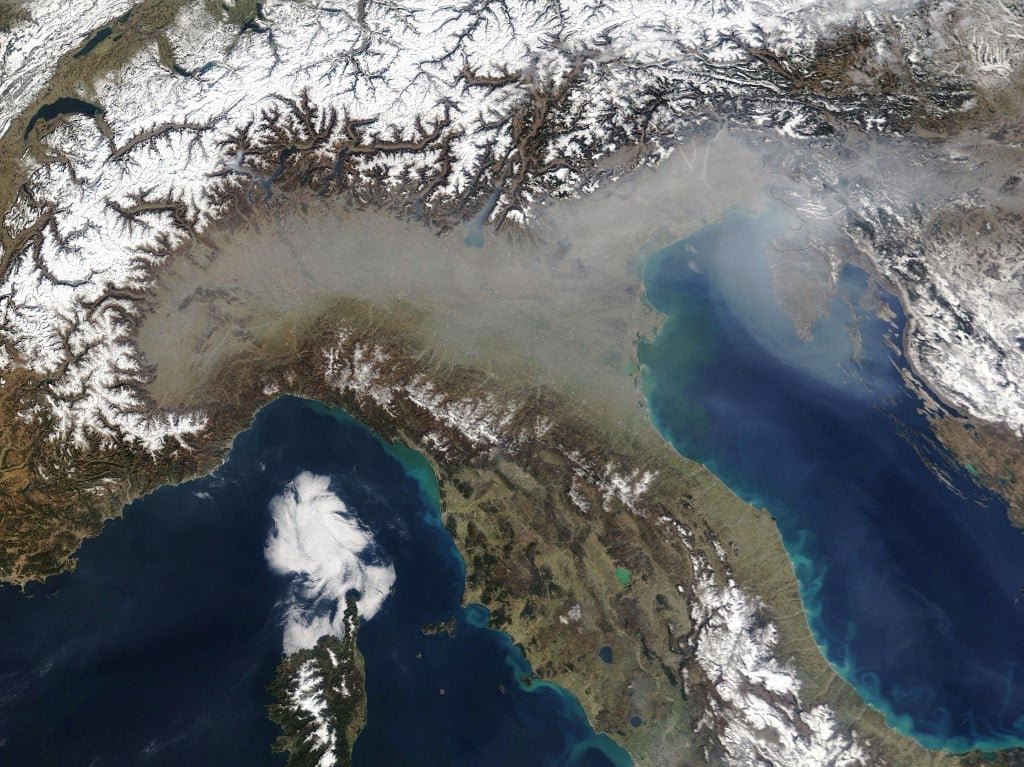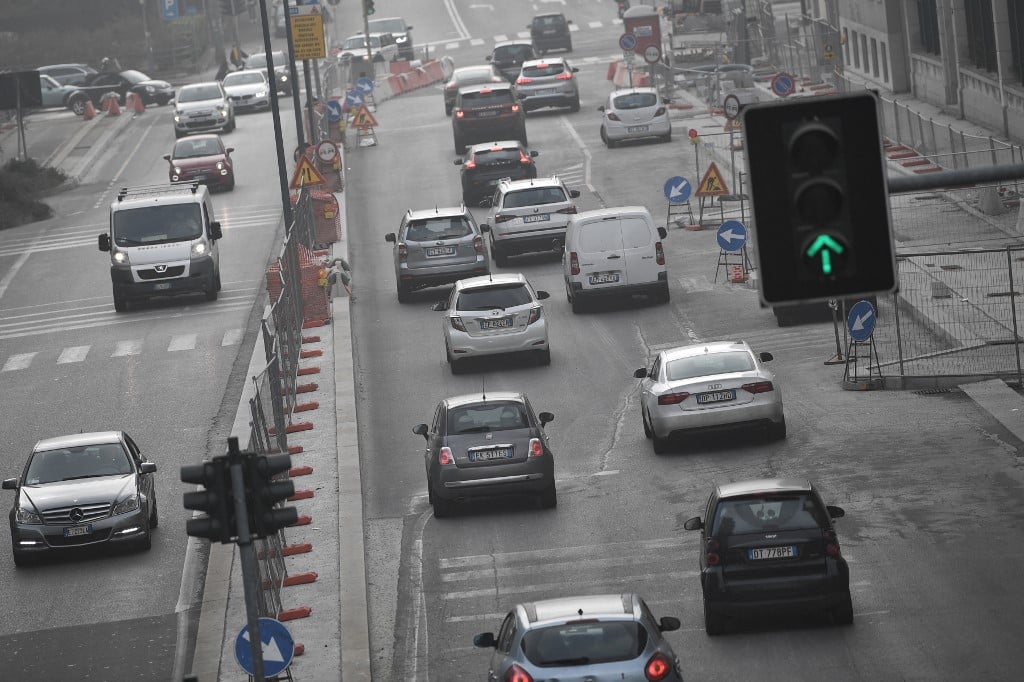Why is air pollution in northern Italy so bad?

The Italian cities of Milan, Turin and Cremona are among the worst areas in Europe for air pollution, new data shows. Why is the situation so bad - and what's being done about it?
The Po Valley, a 48,000-square-kilometre area straddling Piedmont, Lombardy, Veneto and Emilia-Romagna, is the worst area in western Europe and among the worst in the entire continent for air pollution, according to new data.
The study, compiled by academics at Utrecht University and the Swiss Tropical and Public Health Institute for the EU-wide Expanse project, found that more than a third of people living in the valley and surrounding areas breathed air whose concentrations of PM2.5 particles were four times the World Health Organization’s guideline limit.
This placed the Po Valley, or Pianura Padana, behind Serbia and North Macedonia, where more than half of the local population was found to be exposed to PM2.5 levels that were at least four times the WHO figure.
Mapping of the data by The Guardian in September showed the northern Italian region in stark contrast to all other areas of western Europe.
No area of France or Spain saw average readings higher than 14 micrograms a cubic metre, while in Sweden PM2.5 levels did not exceed 10 micrograms.
Why is PM2.5 bad?
PM2.5 (fine particulate matter) is regarded by scientists as one of the most dangerous air pollutants for human health, as a growing body of research proves it’s responsible for a wide range of health problems, from lung and heart disease to diabetes and cancer.
According to the European Environment Agency (EEA), exposure to PM2.5 was responsible for some 238,000 premature deaths across Europe in 2020.
Italian health authorities have estimated that the pollutant may cause over 50,000 early deaths in the country every year.
Where in northern Italy is the situation most critical?
Lombardy’s Milan, Cremona and Monza were the three worst European provinces for air pollution in 2022, as average annual PM2.5 levels exceeded 21 micrograms per cubic metre in all cases, according to research conducted by the European Data Journalism Network in partnership with German broadcaster Deutsche Welle.
As for the current year, average concentrations of PM2.5 in Milan (Lombardy), Verona and Padua (Veneto) were at least four times the WHO limit for multiple consecutive weeks in the first quarter of 2023.
READ ALSO: REVEALED: These are the most polluted towns in Italy
Data about other pollutants are equally alarming as a 2023 report from Italy’s environment watchdog Legambiente found that, of the ten worst cities for PM10 (coarse particulate) pollution, nine were in the Po Valley, with Turin, Milan and Cremona topping the chart.

A thick layer of smog covers Milan's City Life district in February 2020. Photo by Miguel MEDINA / AFP
Why is the Po Valley so heavily polluted?
A number of different factors contribute to the Po Valley being one of the worst places for air pollution in Europe, according to experts.
Firstly, the Pianura Padana is among the most heavily industrialised areas on the continent: Lombardy is the top industrial region in the EU, with Veneto (6th) and Emilia Romagna (9th) also figuring in the top ten.
This translates to high levels of emissions - mainly nitrogen oxides - derived from industrial combustion and manufacturing or refinery processes.
But with over 23 million residents (around 40 percent of the national population), the Po Valley is also a very densely populated area.
Lombardy’s population density (417 inhabitants per square kilometre) is more than two times the national average (195 people/km²) and nearly four times the average EU figure (109 people/km²).
This results in very high local concentrations of pollutants (especially particulate matter and nitrogen oxides) derived from domestic heating and road traffic.
The region’s weather conditions and the influence of nearby mountain ranges also “contribute significantly” to pollution, according to Flavio Galbiati, a meteorologist for Meteo Expert.

A NASA satellite image taken on March 17th 2005 shows a grey veil of haze hovering over the Po Valley. Photo by HO / NASA / AFP
The Alps and Apennines surrounding the Po Valley “affect the wind regime, whose intensity is generally very weak”. This contributes to relatively lengthy periods of air stagnation.
Secondly, the area frequently experiences a phenomenon known as ‘thermal inversion’ during the cold months: the ‘layer’ of air close to the ground becomes colder (and heavier) than the layer above it, which prevents it from rising through the atmosphere.
This creates smog, or, as Galbiati describes it: a “clog that prevents air circulation, trapping pollutants close to the ground, where their concentration can only increase day after day.”
What does the future look like?
While the area’s geographical features cannot be changed, the transport, agriculture and heating sectors could all be regulated to reduce pollution and protect public health according to Legambiente.
Notably, given that “the efficacy of traditional policies against pollution in the Po Valley regions has been decreasing for years”, the area needs a “tight programme of ecological and energy transition”, says Damiano Di Simine, scientific coordinator at Legambiente Lombardia.
This would include a gradual switch to fully electric public transport, the phase-out of combustion vehicles and heating devices using non-renewable sources, and environmentally-friendly city planning.
READ ALSO: 'Social crisis': Italy delays regional ban on old diesel vehicles
But regional authorities in the Po Valley have so far failed to take meaningful and decisive steps, voicing concerns that many of the required measures would hit the local economy as the area produces 40 percent of Italy’s GDP.
Last May, the regional heads of Veneto, Lombardy, Piedmont and Emilia Romagna all opposed new EU directives setting out stringent emission limits and environmental targets to be met by 2030.
In particular, Lombardy’s president Attilio Fontana called the new guidelines “unreasonable”, saying that, if implemented, they would mean “closing 75 percent of manufacturing activities, blocking the circulation of three quarters of current vehicles” and outlawing “more than 60 percent of our heating systems” in what would be a “shutdown of the Po Valley”.

Italy has recently opposed new EU proposals to tighten road vehicle emission standards from 2025. Photo by Marco BERTORELLO / AFP
Northern regions’ hostility towards European air quality policies has so far mirrored the national government’s stance on the issue.
Earlier this year, Rome tried and failed to block EU plans to ban the sale of new cars running on fossil fuels by 2035, with deputy premier and transport minister Matteo Salvini branding the rules "madness" that would "destroy thousands of jobs for Italian workers".
READ ALSO: Why electric cars aren't more popular in Italy
This week, EU legislators watered down plans to tighten vehicle emission standards from 2025, following lobbying from a united front of eight member states including Italy.
This was hailed as a victory by Business and Made in Italy Minister Adolfo Urso, who said “reason had won over ideology” and Europe had sidestepped “a chasm for the [car] industry, business and workers”.
Comments (1)
See Also
The Po Valley, a 48,000-square-kilometre area straddling Piedmont, Lombardy, Veneto and Emilia-Romagna, is the worst area in western Europe and among the worst in the entire continent for air pollution, according to new data.
The study, compiled by academics at Utrecht University and the Swiss Tropical and Public Health Institute for the EU-wide Expanse project, found that more than a third of people living in the valley and surrounding areas breathed air whose concentrations of PM2.5 particles were four times the World Health Organization’s guideline limit.
This placed the Po Valley, or Pianura Padana, behind Serbia and North Macedonia, where more than half of the local population was found to be exposed to PM2.5 levels that were at least four times the WHO figure.
Mapping of the data by The Guardian in September showed the northern Italian region in stark contrast to all other areas of western Europe.
No area of France or Spain saw average readings higher than 14 micrograms a cubic metre, while in Sweden PM2.5 levels did not exceed 10 micrograms.
Why is PM2.5 bad?
PM2.5 (fine particulate matter) is regarded by scientists as one of the most dangerous air pollutants for human health, as a growing body of research proves it’s responsible for a wide range of health problems, from lung and heart disease to diabetes and cancer.
According to the European Environment Agency (EEA), exposure to PM2.5 was responsible for some 238,000 premature deaths across Europe in 2020.
Italian health authorities have estimated that the pollutant may cause over 50,000 early deaths in the country every year.
Where in northern Italy is the situation most critical?
Lombardy’s Milan, Cremona and Monza were the three worst European provinces for air pollution in 2022, as average annual PM2.5 levels exceeded 21 micrograms per cubic metre in all cases, according to research conducted by the European Data Journalism Network in partnership with German broadcaster Deutsche Welle.
As for the current year, average concentrations of PM2.5 in Milan (Lombardy), Verona and Padua (Veneto) were at least four times the WHO limit for multiple consecutive weeks in the first quarter of 2023.
READ ALSO: REVEALED: These are the most polluted towns in Italy
Data about other pollutants are equally alarming as a 2023 report from Italy’s environment watchdog Legambiente found that, of the ten worst cities for PM10 (coarse particulate) pollution, nine were in the Po Valley, with Turin, Milan and Cremona topping the chart.

Why is the Po Valley so heavily polluted?
A number of different factors contribute to the Po Valley being one of the worst places for air pollution in Europe, according to experts.
Firstly, the Pianura Padana is among the most heavily industrialised areas on the continent: Lombardy is the top industrial region in the EU, with Veneto (6th) and Emilia Romagna (9th) also figuring in the top ten.
This translates to high levels of emissions - mainly nitrogen oxides - derived from industrial combustion and manufacturing or refinery processes.
But with over 23 million residents (around 40 percent of the national population), the Po Valley is also a very densely populated area.
Lombardy’s population density (417 inhabitants per square kilometre) is more than two times the national average (195 people/km²) and nearly four times the average EU figure (109 people/km²).
This results in very high local concentrations of pollutants (especially particulate matter and nitrogen oxides) derived from domestic heating and road traffic.
The region’s weather conditions and the influence of nearby mountain ranges also “contribute significantly” to pollution, according to Flavio Galbiati, a meteorologist for Meteo Expert.

The Alps and Apennines surrounding the Po Valley “affect the wind regime, whose intensity is generally very weak”. This contributes to relatively lengthy periods of air stagnation.
Secondly, the area frequently experiences a phenomenon known as ‘thermal inversion’ during the cold months: the ‘layer’ of air close to the ground becomes colder (and heavier) than the layer above it, which prevents it from rising through the atmosphere.
This creates smog, or, as Galbiati describes it: a “clog that prevents air circulation, trapping pollutants close to the ground, where their concentration can only increase day after day.”
What does the future look like?
While the area’s geographical features cannot be changed, the transport, agriculture and heating sectors could all be regulated to reduce pollution and protect public health according to Legambiente.
Notably, given that “the efficacy of traditional policies against pollution in the Po Valley regions has been decreasing for years”, the area needs a “tight programme of ecological and energy transition”, says Damiano Di Simine, scientific coordinator at Legambiente Lombardia.
This would include a gradual switch to fully electric public transport, the phase-out of combustion vehicles and heating devices using non-renewable sources, and environmentally-friendly city planning.
READ ALSO: 'Social crisis': Italy delays regional ban on old diesel vehicles
But regional authorities in the Po Valley have so far failed to take meaningful and decisive steps, voicing concerns that many of the required measures would hit the local economy as the area produces 40 percent of Italy’s GDP.
Last May, the regional heads of Veneto, Lombardy, Piedmont and Emilia Romagna all opposed new EU directives setting out stringent emission limits and environmental targets to be met by 2030.
In particular, Lombardy’s president Attilio Fontana called the new guidelines “unreasonable”, saying that, if implemented, they would mean “closing 75 percent of manufacturing activities, blocking the circulation of three quarters of current vehicles” and outlawing “more than 60 percent of our heating systems” in what would be a “shutdown of the Po Valley”.

Northern regions’ hostility towards European air quality policies has so far mirrored the national government’s stance on the issue.
Earlier this year, Rome tried and failed to block EU plans to ban the sale of new cars running on fossil fuels by 2035, with deputy premier and transport minister Matteo Salvini branding the rules "madness" that would "destroy thousands of jobs for Italian workers".
READ ALSO: Why electric cars aren't more popular in Italy
This week, EU legislators watered down plans to tighten vehicle emission standards from 2025, following lobbying from a united front of eight member states including Italy.
This was hailed as a victory by Business and Made in Italy Minister Adolfo Urso, who said “reason had won over ideology” and Europe had sidestepped “a chasm for the [car] industry, business and workers”.
Join the conversation in our comments section below. Share your own views and experience and if you have a question or suggestion for our journalists then email us at [email protected].
Please keep comments civil, constructive and on topic – and make sure to read our terms of use before getting involved.
Please log in here to leave a comment.